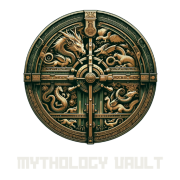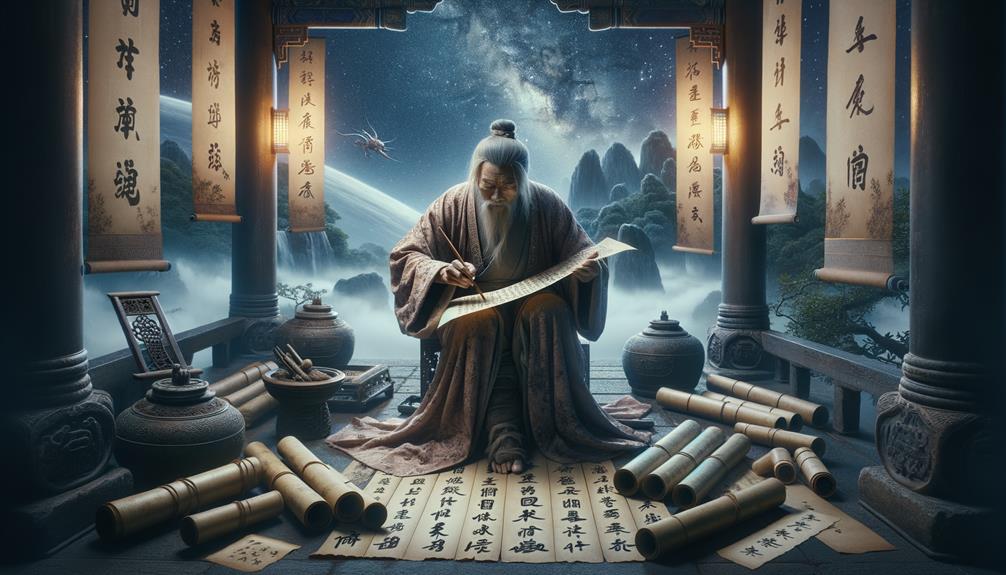I have gathered as much information as I could find, inspired by the Yellow Emperor, to learn how we transformed primitive symbols into an organized writing system. This pioneering script continues to shape our world, an ongoing adventure interwoven into the fabric of society.
The Legend of Cangjie
Long ago, during ancient China’s mythic era, Cangjie’s legend unfolded through his journey to revolutionize communication. As an official under the revered Yellow Emperor, Cangjie felt a profound responsibility to ease his people’s burdens. The primitive method of using shells and knots on ropes failed to facilitate complex idea and information exchange. Cangjie yearned for a solution transcending the era’s limitations.
Driven by inspiration and purpose, Cangjie embarked on a quest. His mission was clear: create a new writing system that would bring clarity and connection to their civilization. The wise and farsighted Yellow Emperor supported Cangjie’s endeavor, blessing his venture into uncharted territory to unravel communication’s mysteries.
Through meticulous observation and relentless dedication, Cangjie began forming symbols representing the world around them. These symbols, later known as Chinese characters, embodied their culture, history, and essence. Presenting this new writing system to the Yellow Emperor marked a transformative era dawning in ancient China.
Inspiration From Nature

When creating Chinese characters, I drew inspiration from the natural world around me. The distinct tracks left by animals, intricate patterns in plants, and diverse elements of the landscape revealed secrets of form and meaning. These observations transformed into sacred symbols that revolutionized our communication methods.
Observing Animal Tracks
With the patience of a skilled observer, Cangjie studied the intricate patterns of animal tracks, turning nature’s imprints into the foundation of Chinese characters. I admired his keen eye for detail as he meticulously observed each track’s traits. The deer’s delicate hoof, the bear’s formidable claw, and the bird’s gentle imprint – each spoke a unique language, revealing secrets of the natural world. Cangjie recognized these messages and translated them into enduring symbols.
In his solitary quest, Cangjie embodied the archetypal explorer, journeying through the wilderness, guided by his unique vision. His ability to perceive what others overlooked set him apart. Each track became a crucial clue, a piece of the cosmic puzzle he was destined to solve.
He didn’t merely see tracks; he saw the essence of movement, life, and interaction. This profound understanding allowed him to craft symbols that captured the spirit of these creatures. As a result, Chinese characters emerged, each stroke a reflection of his journey and ingenuity.
Cangjie’s work revolutionized communication, creating a bridge between nature and humanity. His legacy endures, an explorer whose vision transformed the written word.
Patterns in Plant Life
Captivated by nature’s intricacies, Cangjie delved into the complex patterns of plant life, seeking inspiration for his pioneering writing system. He wandered through forests and fields, each leaf, stem, and flower speaking silently yet profoundly.
Cangjie’s sharp eyes studied the delicate veins of leaves, spiraling tendrils, and symmetrical blossoms. He perceived more than just plants – a language of existence woven into nature’s fabric. These intricate designs became maps guiding his creation of the earliest Chinese characters.
Deciphering nature’s scripts, Cangjie drew parallels between the forms he observed and the symbols he envisioned. A leaf’s veins mirrored life’s pathways; a flower’s bloom captured growth and beauty’s essence. Every observation revealed something new, each pattern bringing him closer to the divine knowledge he sought.
Through this mythic journey, Cangjie’s intimate connection with nature’s designs birthed a writing system transcending mere marks. The patterns of plant life, interwoven into Chinese characters, became a tribute to nature’s boundless creative force.
Elements of the Landscape
Cangjie found inspiration in nature’s grandeur as he developed Chinese characters. Each step revealed unique stories – towering mountains standing guard, jagged peaks and flowing rivers becoming etched symbols. The landscape didn’t merely provide a backdrop; it served as a powerful muse.
Cangjie observed the play of shadows across mountainsides, meandering river paths, and intricate designs left by animals. Every rock, tree, and stream spoke to him, urging the capturing of their essence in written form. The rugged terrain and serene waters formed the foundation for his innovative approach.
Cangjie’s profound connection to the natural world allowed translation of raw beauty into interconnected symbols of life itself. Through his perspective, the landscape transcended mere sight – it became eternally engraved into the heart of Chinese characters.
Early Chinese Writing

In ancient China‘s distant past, the need for a better way to record the world’s marvels sparked the creation of intricate symbols that would forever alter history’s course. Driven by this profound necessity, the legendary Cangjie embarked on an extraordinary journey transcending human understanding. Observing the world, he found meaning in animal footprints, star patterns, and river flows. From these observations, he crafted the first Chinese characters, a written language capturing the essence of everything around him.
Cangjie’s writing system emerged as a groundbreaking development in ancient China. No longer limited by rope knots, his symbols offered a new way to record and recognize information. Each character he created embodied layers of meaning, meticulously organized to represent the vast array of objects and ideas encountered by the ancient Chinese.
When Cangjie presented his complete set of characters to Emperor Huangdi, he introduced not just a tool but a revolution. His invention became the cornerstone of Chinese culture, deeply intertwined with their identity and history.
Impact on Communication
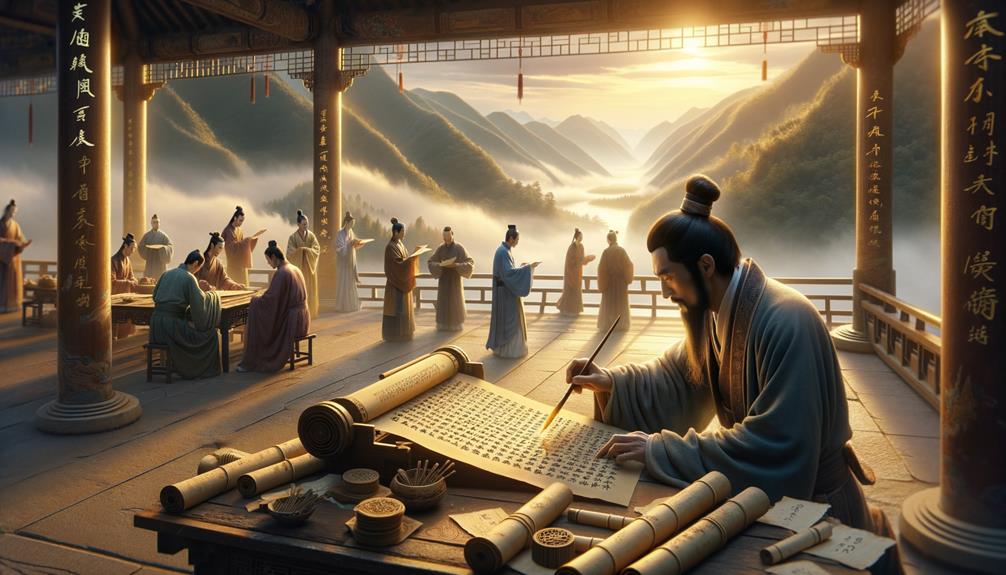
Cangjie’s invention of Chinese characters significantly reshaped communication and knowledge preservation in ancient times. People transitioned from solely relying on oral traditions to a sophisticated written system designed to last millennia.
This writing system brought clarity and organization to the previously chaotic realm of communication. Recording and transmitting information became possible, bridging generational and regional gaps. Logically arranged characters enabled cultural and intellectual exchange, serving as society’s lifeblood.
Reflect on the far-reaching impact:
- Documenting Wisdom: Knowledge could now be recorded and shared across generations without loss.
- Clear Messaging: Precise writing reduced misunderstandings in communication.
- Cultural Cohesion: Diverse regions could interact more effectively, fostering a shared identity.
- Advancing Civilization: This foundation paved the way for developments in law, literature, science, and other fields.
Cangjie’s characters weren’t just a tool; they enlightened ancient China, guiding it into a new era. His legacy shaped the communication landscape for centuries, transcending a mere writing system.
Evolution of Characters
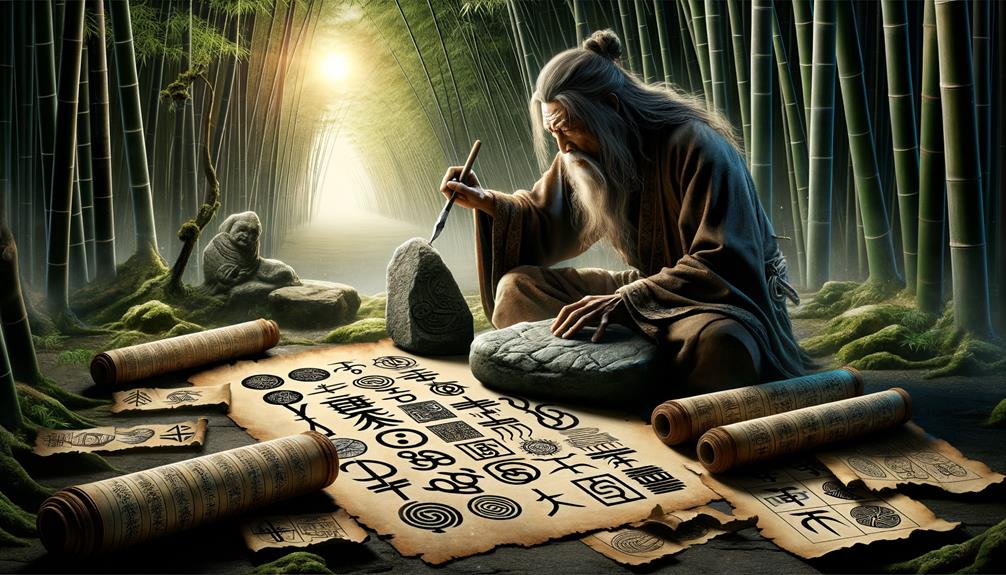
The evolution of Chinese characters tells a remarkable story. Over centuries, dynasties crafted and streamlined Cangjie’s ancient symbols into their modern forms. This tireless effort to simplify and standardize weaves a rich cultural tapestry, connecting past and present while honoring Cangjie’s visionary work.
These refined characters mirror humanity’s perpetual quest for perfection. With each generation, scribes and scholars honed the symbols, improving legibility and efficiency. Their meticulous revisions forged an iconic visual language that transcends time.
Even today, Cangjie’s descendants refine this ever-evolving script. Modern typographers and designers continue shaping character sets, adapting them to contemporary needs. From chiseled stone to digital screens, Chinese characters endure as a living legacy of human ingenuity and perseverance.
Simplification Over Centuries
The journey of Chinese characters, originating from Cangjie’s mythical creation, winds its way through centuries of transformation and resilience. These ancient symbols endured numerous evolutions, each chapter molding them into diverse calligraphic styles like kaishu and lishu.
Tracing their metamorphosis reveals key adaptations:
- Streamlined Forms: Intricate symbols gradually simplified for easier writing and reading.
- Cultural Fusion: Buddhist and Japanese influences enriched the lexicon, weaving a shared heritage.
- Modern Reforms: Communist policies in the 1950s simplified over 2,000 characters, altering meanings and artistic traditions.
- Preserved Roots: Despite modernization efforts, original characters remain cherished, especially in calligraphic arts.
This tale of simplification isn’t just about a language evolving – it captures a resilient spirit, adapting while clinging to its origins. Chinese characters, born from Cangjie’s vision, endure as a unique logographic testament to human ingenuity.
Influence of Dynasties
Cangjie’s characters evolved under the dynasties’ influence, a journey reflecting each empire’s identity. The Qin dynasty enforced the seal script, centralizing writing like the emperor’s authority. Then came the Han, simplifying characters for bureaucracy’s growth.
The Tang codified standards across domains. Calligraphy peaked under the Song, with brushstrokes dancing cultural essence onto parchment.
Each dynasty imprinted its character on the script, shaping language to mirror society’s transformation through the ages. The written word mirrored the shifts in power, ideology, and the spirit of the era.
Modern Standardization Process
Cangjie’s legendary characters marked the start of a transformative journey, steadily evolving into modern standardization that has preserved ancient Chinese civilization’s essence. As I ponder this monumental progression, I see Cangjie’s systematic writing system as a pioneering breakthrough that revolutionized communication.
The journey didn’t halt with Cangjie. Over millennia, Chinese characters adapted through various scripts, each phase shaping their path. From oracle bone inscriptions to jiaguwen, kaishu, and lishu calligraphic styles, every transformation exemplified the characters’ resilience and malleability.
Today’s standardization process, the culmination of this transformative saga, embodies ancient China’s spirit. It ensures Chinese characters retain their distinctive essence despite temporal and cultural shifts. This process involves:
- Unifying diverse cultures: Standardizing characters bridges regional dialects.
- Preserving heritage: The characters link the present to the past.
- Facilitating communication: A unified script simplifies learning and usage.
- Demonstrating adaptability: The enduring nature of Chinese characters showcases their flexibility.
In this epic narrative, the conception and evolution of Chinese characters stand testament to human ingenuity and cultural perseverance.
Cultural Significance
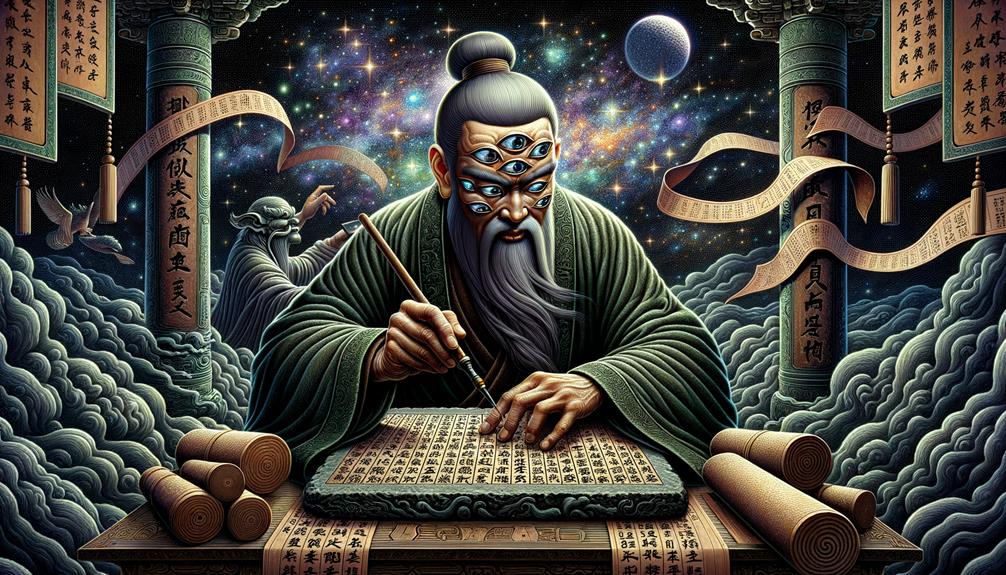
In the heart of ancient China, Cangjie’s creation of characters marked a pivotal shift that forever transformed Chinese culture. This groundbreaking act wasn’t merely the birth of a writing system; it ushered in a new era, enabling the preservation and dissemination of knowledge across generations.
Chinese characters transcended their role as mere symbols; they embodied the essence of Chinese identity and history. Through these characters, stories, philosophies, and traditions were woven into the fabric of civilization, creating a rich tapestry of cultural significance. Cangjie is revered as a pioneering figure whose invention laid the foundation for a unified cultural heritage.
As we examine Cangjie’s journey, we see how his creation resonated through millennia, deeply ingraining itself in the Chinese psyche. Today, the enduring significance of Chinese characters stands as a testament to their historical importance. They are not just a means of communication; they are the heart and soul of Chinese culture, a legacy that continues to define and inspire.
Frequently Asked Questions
Who Invented Chinese Characters?
I wanted to explore the inventor of Chinese characters. Cangjie, a respected cultural figure, devised them after closely observing patterns in nature, turning symbols into a groundbreaking writing system. His endeavor left an indelible influence on our heritage.
How Did They Come up With Chinese Characters?
I embarked on a journey, seeking inspiration from the world around me. Observing animal tracks and celestial patterns, I designed symbols mirroring nature, weaving a visual language that transformed how we communicate.
Who Is the Legendary Inventor of Chinese Writing?
The legendary creator of Chinese writing was Cangjie. The tale goes that he drew inspiration from nature, devising symbols he then presented to Emperor Huangdi. His innovative system laid the foundation for the written Chinese language we know today.
Who Invented the Chinese Keyboard?
In 1976, Dr. Chu Bong-Foo revolutionized Chinese language input with his innovative keyboard design. Drawing inspiration from the ancient Cangjie system, he crafted a practical tool bridging tradition and modernity. This keyboard transformed typing in Chinese, seamlessly merging the past’s wisdom into our present technological landscape.
